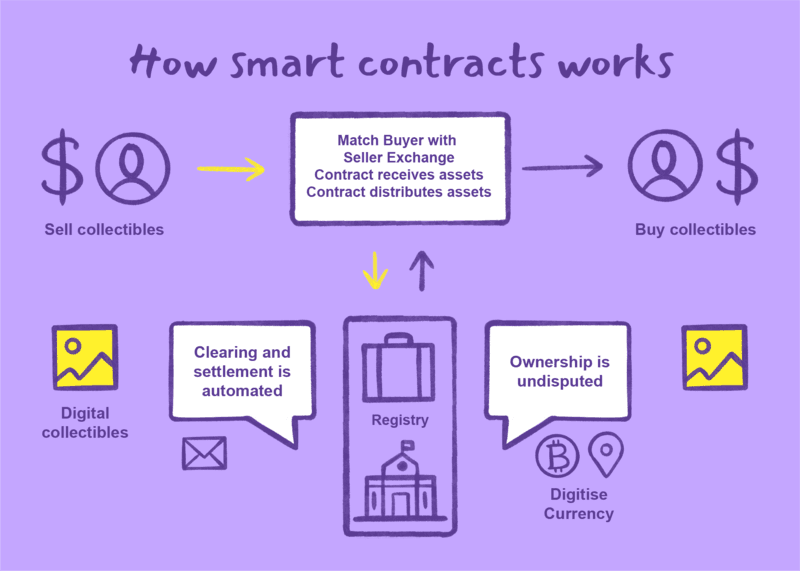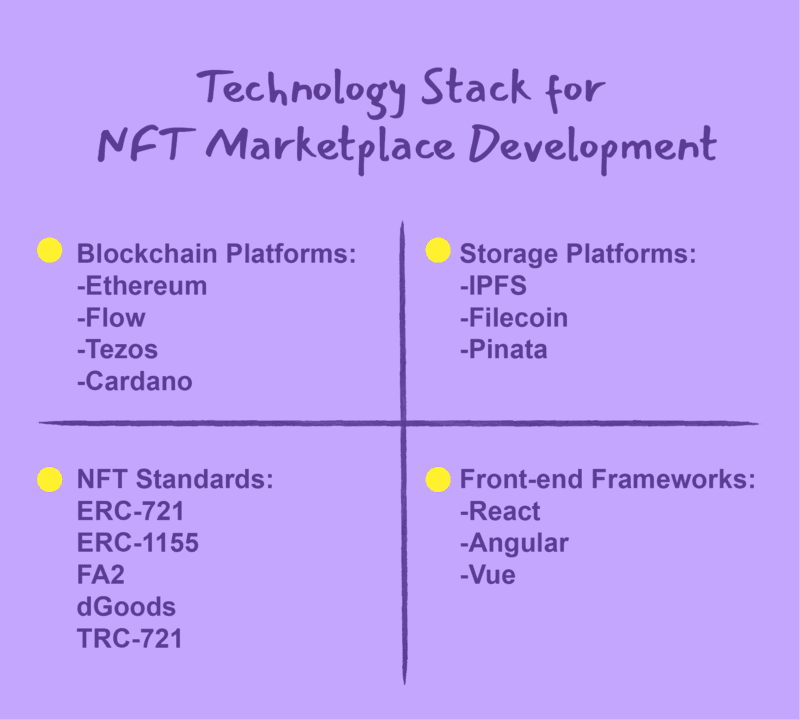NFTs are unique products of cryptography. Each of them is inimitable and exists in a single copy. Being stored in the blockchain, it is immune to fakes. That's why NFT tokens are attracting more and more attention. Among those fascinated by them are ardent collectors seeking to own unique digital objects.
The popularity of NFT-based art is growing year by year, especially during the pandemic (whereas sales of physical art have plummeted). And the demand keeps growing: the total value of NFT transactions at the beginning of 22 amounted to more than $300 million, which exceeded the sales level for the entire past year.
All of the above leads to a logical conclusion: it's high time to develop an NFT platform and start making money on it. And in our article, we’re going to tell you how to do it.
What is an NFT Marketplace and How it Works
How the NFT Marketplace Works
An NFT marketplace represents the online platform where the users can sell and purchase non-fungible tokens. These tokens play a central role as they grant ownership and promote the trade of digital assets like a piece of art, music, virtual collectibles, etc. Each NFT has its unique identification code, which makes them non-fungible or distinguished and non-replaceable. The identification code alleviates the process of token transfer and verification.
A non-fungible token platform operates on the basis of so-called smart contracts. Their peculiarity is that they’re self-fulfilling and don’t depend on the human factor. An NFT smart contract is a programmatic code that contains the rules of the non-fungible token in the blockchain. Additionally, blockchain is a basis for non-fungible tokens, smart contracts, and crypto wallets. If you are interested in clarifying how to make a Bitcoin wallet, feel free to read the linked article.
From this point, this type of programming contract ensures the seller’s ownership of the digital asset. Therefore, the parties to the transaction don’t have to trust each other.

Smart contracts supplement a token with unique data about the product it’s connected to, after which the NFT item is open to sales or auction. And the purchase money is debited from the buyer's account only if the terms of the transaction are met. Otherwise, the deal is considered invalid, which leads to its automatic termination. Of course, such an approach reduces and even eliminates fraud attempts. That's why smart contracts are so popular right now.
As you can see, the whole thing is very clear and simple.
Top 3 NFT Platforms
Rarible
Rarible is an NFT art marketplace that offers versatile opportunities like mining, buying, creating and trading tokens via online auction. The uniqueness of this platform is its blockchain flexibility. Users can tailor their NFT based on multiple blockchain platforms, such as Solana, Ethereum, and Polygon.
OpenSea
Users can place and distribute their tokens at a fixed price. The marketplace operates blockchain networks like Polygon, Bitcoin, and Ethereum. Buyers have two options: to purchase the token of a valuable collectible, like a music piece, or a digital asset like the domain name.
Mintable
Mintable sells digital art, photography, and games. The trade platform’s unique feature is its blockchain architecture. The marketplace represents the peer-to-peer transaction, which excludes the necessity of the third party’s participation. The platform is Ethereum blockchain-based.
Must-Have Features of Your NFT Marketplace

Let's consider the most essential features, without which your resource won’t work as it should:
-
Account-related features. We see no point to detail the features common to almost all sites and applications: registration, account creation & management, and so on.
-
Storefront. Any store, including those based on NFT, should have some kind of storefront. This applies to both physical stores and online ones. Therefore, you must provide the user with the opportunity to create his seller page in a few clicks, without extra steps.
-
Search system. Also, features of your NFT marketplace should include the ability to search for products. Pretty obvious, right?
-
Filters. The feature is related to the previous one: to be precise, before initiating a search, the customer specifies his wishes using filters.
-
Creating listings. The feature is targeting sellers. They create listings and manage the sales process.
-
Buying or bidding. Don't forget about buyers either: offer a simple, clear way to purchase the NFT item (through a traditional sale or with the help of an auction).
-
Digital wallet. And of course, you need to add a wallet, without which it’d be very difficult to perform monetary transactions.
These features are quite enough to build an NFT marketplace (in the end, it's better to start small than not to start at all). However, if you want more, consider additional options such as:
-
Interactive chat to initiate real-time communication between buyers and sellers;
-
Wishlist: the perfect solution to boost sales. The user may be limited in funds right now, but it doesn't mean he won't be able to buy the product of interest later. And there are more chances to make this happen if the desired items are placed in a separate list (Wishlist);
-
Chatbot, whose task is to answer users' questions around the clock (even at midnight);
-
Comparison of goods, which will also make your resource more attractive in the eyes of users.
And now it's time to discuss the NFT-platform development process, step by step.
How to Create NFT Marketplaces in 7 Steps?
Initial preparation
-
You should start by understanding what you have to deal with.
-
How long will the project last?
-
What budget do you need to implement it?
-
What will increase the chances of its success?
The smartest option is to order the discovery service instead of trying to do research on your own. Experienced professionals will determine the key project requirements and suggest the best way to act.
Hiring performers
If you hire discovery specialists to carry out the preparatory stage of the project, you’ll be able to find the developers much easier. The thing is, Discovery and Delivery teams often work together.
UI/UX
The discovery phase often involves creating an initial prototype of your website or app. And in this case, you can immediately proceed with building a detailed interface design. Otherwise, you'll have to start with prototyping.
MVP
If you're on a tight budget, start small by developing an MVP (an NFT trading platform with a minimal set of features). You can improve it later when you realize you’ve chosen the right strategy.
Testing
Test your project on end-users. Do they like what they see? What should be improved?
Project release
So, you've added new features to the project and corrected its shortcomings. Now you can release the final version of the NFT marketplace. Of course, you'll keep improving it in the future, because working on a digital product is an endless process, but the first difficult stage has remained behind.
Project improvement
As we said, keep evolving your product: collect user feedback, implement new features, and improve old ones. Updating functionality is the only way to succeed in building an NFT platform.
Tech Stack to Build an NFT Marketplace
Of course, the developers you hire know how to create NFT marketplaces (at least they should). But just in case, we’d like to show what technologies will help you implement the project.

How to Make Money with NFT Marketplace?
We’re 100% sure you’re eager to learn how NFT marketplaces make money and how you can monetize your own NFT platform. The most optimal ways are:
-
Sales commission. If you want to create your own NFT marketplace you have to know that the seller pays a certain commission for each NFT product sold (usually about 5-10%).
-
Ads. Advertising is a great way to monetize any website or application, including platforms for NFT trading. Just make sure your ads aren't too intrusive (or you risk annoying your users).
-
Paid promotion. If you want your NFTs to get to the top more easily, you are welcome to resort to a paid promotion.
-
Listing fees. Another commission option, this time it's a per-listing fee.
-
Paid features. And finally, why not make some of the features (those that aren't included in the basic set) paid?
Conclusion
We've elucidated versatile details on how to build your own NFT marketplace. When you get started with crafting non-fungible token platforms, you need to keep in mind major performers, UX/UI, MVP, and testing. You can achieve token monetization by ads, paid promotion, listing fees, and paid commissions. Now you know how to approach the NFT-platform development process without unnecessary risks. And if you're ready to move from words to deeds, write to us, and we'll discuss your project in more detail.